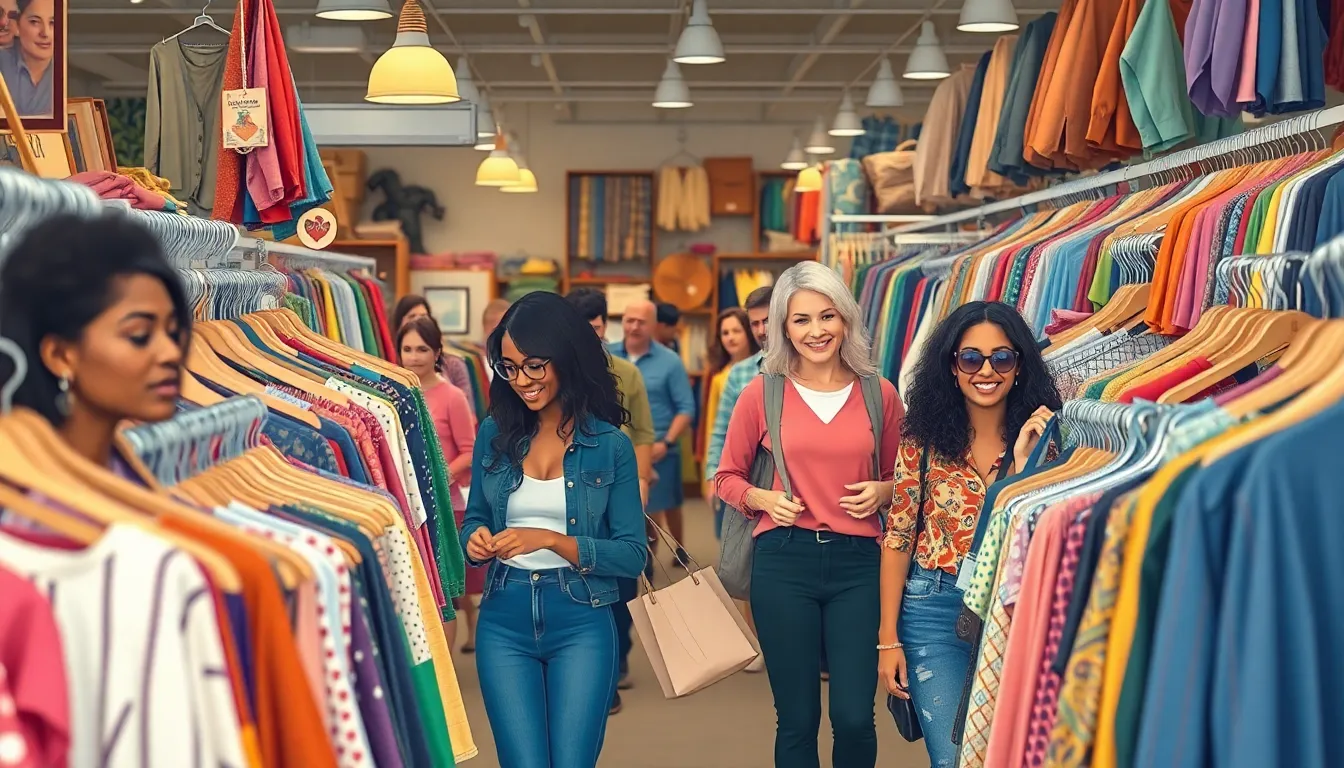Thrift shopping isn’t just a way to save a few bucks; it’s a treasure hunt that can turn a mundane Saturday into an adventure. Imagine sifting through racks of unique finds, where every item has a story, and you might just snag that vintage jacket that makes you the envy of your friends. Who knew saving money could feel this glamorous?
Table of Contents
ToggleWhat Is Thrift Shopping?
Thrift shopping refers to purchasing second-hand items, typically from consignment stores, charity shops, or garage sales. Shoppers often find clothing, furniture, and household goods at significantly reduced prices. Discovering unique pieces makes this experience appealing, as each item carries its own history and character.
Participants engage in the thrill of searching. They sift through racks of clothing, piles of books, and tables of assorted goods. Expect surprises, as items often range from trendy to unusual, fostering creativity in personal style.
Many individuals appreciate thrift shopping for its environmental benefits. By buying second-hand, shoppers contribute to sustainability efforts and reduce waste in landfills. Each purchase supports local charities or small businesses, creating a positive impact on the community.
Trendy fashion statements frequently emerge from identifying quality vintage pieces. These often lead to one-of-a-kind outfits that stand out. Retro items like vintage jackets or unique accessories can become conversation starters, showcasing individuality.
Online platforms also play a role in the thrift shopping experience. Websites and apps facilitate the buying and selling of second-hand goods, expanding the range of available items. Digital thrifting allows hobbyists and bargain hunters to connect across distances, opening up new possibilities for finding treasures.
Overall, thrift shopping embraces the art of searching for hidden gems while promoting sustainable consumer habits. Emphasis on uniqueness and affordability attracts diverse groups of shoppers, each seeking value in their purchases.
Benefits of Thrift Shopping

Thrift shopping offers several advantages, appealing to a wide range of consumers.
Sustainability and Environment
Thrift shopping promotes sustainability by extending the life cycle of items. Purchasing second-hand products reduces the demand for new manufacturing, which can decrease waste and pollution. Many thrift stores contribute to environmental initiatives, further enhancing their positive impact. Shoppers help reduce textile waste, with millions of tons ending up in landfills annually. It’s an eco-friendly choice benefiting the planet while fulfilling personal needs.
Saving Money
Thrift shopping provides significant savings on clothing, furniture, and other household items. Shoppers often find quality products at a fraction of the retail price. On average, second-hand items can cost 50% to 90% less than new equivalents. This affordability allows individuals to stretch their budgets, making it easier to cultivate a diverse wardrobe or furnish a home without overspending. Both casual shoppers and bargain hunters appreciate the financial benefits of thrifting.
Unique Finds
Discovering unique finds adds an element of excitement to thrift shopping. Each item has a distinct history, making them one-of-a-kind treasures. Shoppers often encounter vintage clothing, rare books, and eclectic home décor that can’t be found in traditional stores. These unique items not only elevate personal style but also serve as conversation starters. A well-curated collection of thrifted pieces can reflect individual creativity and personal taste, setting shoppers apart from the mainstream.
Tips for Successful Thrift Shopping
Thrift shopping offers a rewarding experience when approached with the right strategies. Here are key tips to enhance the adventure.
Researching Local Thrift Stores
Explore local thrift store options before heading out. Online reviews highlight popular shops, while social media showcases unique items in stock. Consider visiting stores that support local charities, as they often boast a good selection. Maps or thrift store directories provide easy navigation to nearby locations. Connecting with local thrift shopping groups can yield valuable recommendations too.
Knowing What to Look For
Identify key items that suit personal style during thrift shopping trips. Prioritize quality over brand name when selecting clothing or accessories. Look for unique pieces, such as vintage clothing or distinctive home décor, that elevate individual aesthetics. Inspect items carefully for signs of wear, ensuring they can withstand regular use. Don’t shy away from exploring various categories, as unexpected treasures often await in different sections.
Timing Your Visits
Plan visits for optimal treasure hunting. Weekdays generally offer fewer crowds, allowing for a relaxed shopping experience. Mornings often deliver freshly stocked shelves, maximizing discovery potential. Special sales and clearance events provide excellent opportunities to snag amazing deals. Keep an eye on store schedules, as some locations offer specific days for discounted items.
Thrift Shopping Trends
Thrift shopping trends reflect a growing interest in sustainable and unique styles. The rise of eco-conscious consumers drives many to prefer second-hand options. Vintage pieces frequently dominate fashion scenes, showcasing eclectic aesthetics and personal expression. Shoppers often seek distinctive items that tell a story, turning thrift stores into treasure troves of unique finds.
Social media platforms, particularly Instagram and TikTok, influence thrift shopping trends. Influencers showcase their thrifted outfits, inspiring followers to explore second-hand fashion. This exposure elevates the awareness of quality vintage clothing and its ability to create standout styles. Shoppers discover that thrift shopping provides both a sustainable choice and an avenue for creativity.
Additionally, themed shopping events and pop-up thrift markets gain popularity. These events curate specific styles or categories, encouraging community participation and collaboration. Shoppers appreciate not only the variety but also the social experience of hunting for treasures together. Community-focused thrift events reinforce the idea of connecting with local businesses and supporting charitable causes.
Seasonal changes also impact thrift shopping trends. As styles evolve, shoppers eagerly seek items that align with upcoming seasons and trends. Spring cleaning inspires fresh inventory, while back-to-school sales create opportunities for students to find budget-friendly fashion. Eco-friendly initiatives continue to inspire shoppers to choose second-hand over fast fashion, further driving thrift shopping’s appeal.
Consumer preferences shift toward quality over quantity, prompting thrift stores to curate selections. Sustainable brands and resale platforms promote responsible consumer habits, making thrifting a desirable lifestyle choice. Through these supportive trends, thrift shopping stands out as both a chic practice and an environmentally conscious decision that resonates widely.
Thrift shopping offers a unique blend of adventure and sustainability that appeals to a wide audience. It’s not just about saving money; it’s about uncovering stories and expressing individuality through one-of-a-kind finds. As shoppers embrace this eco-friendly lifestyle, they’re not only enhancing their wardrobes but also supporting local communities and reducing waste.
With the rising popularity of vintage and second-hand items, thrift shopping is becoming a chic and responsible choice for those seeking style without compromise. By exploring local shops and staying attuned to trends, anyone can make the most of their thrift shopping experience. This practice isn’t just a trend; it’s a movement that champions creativity and environmental consciousness.

